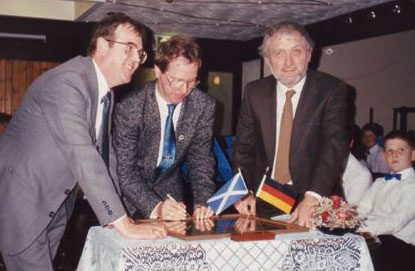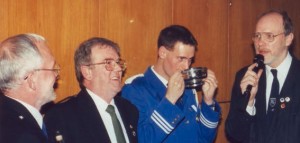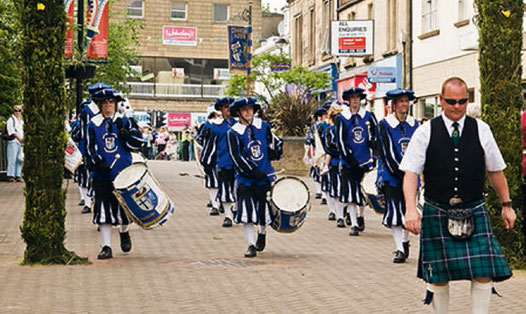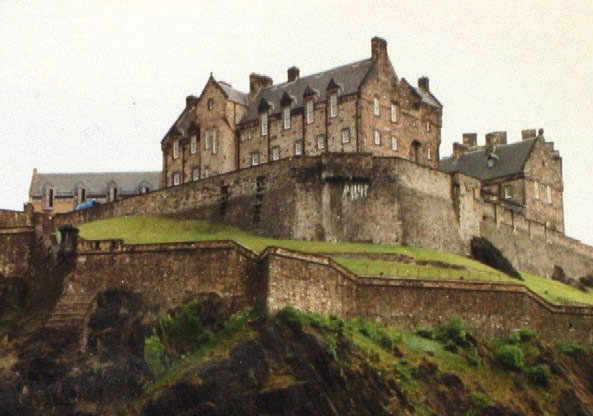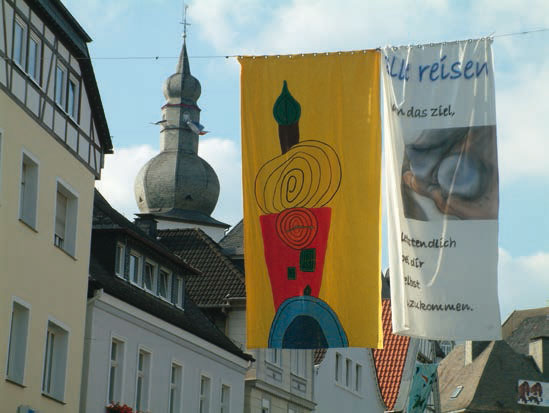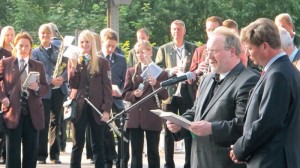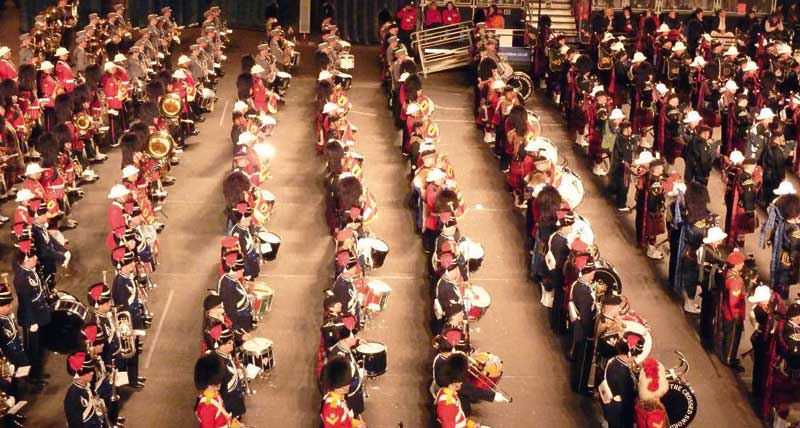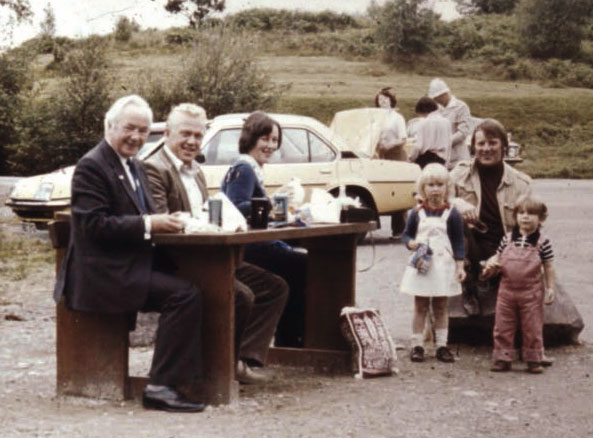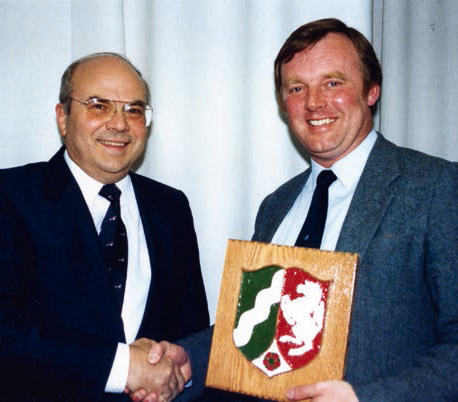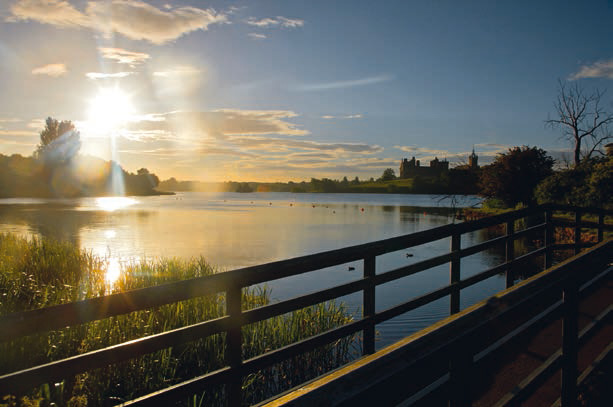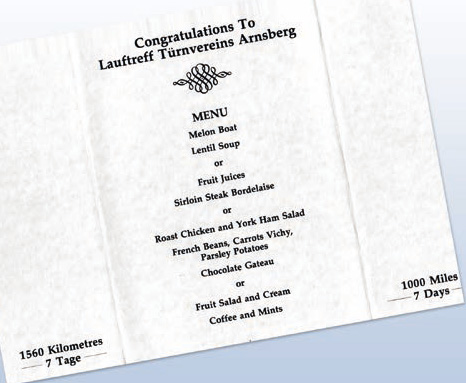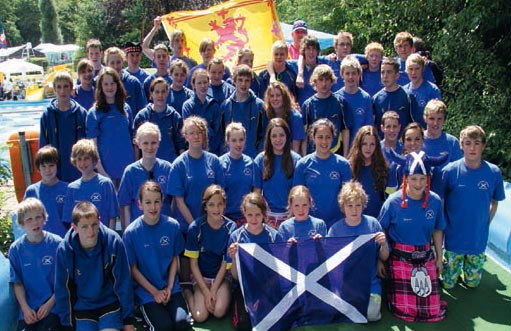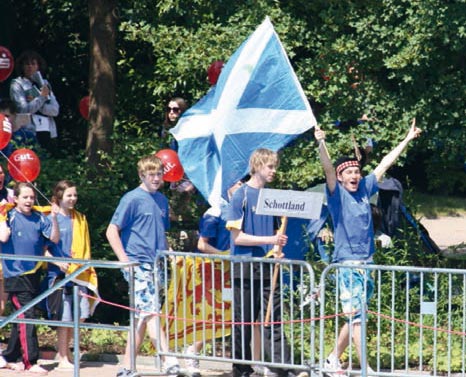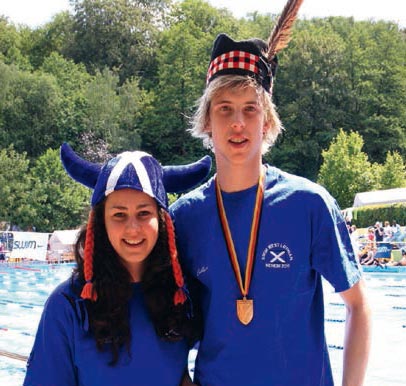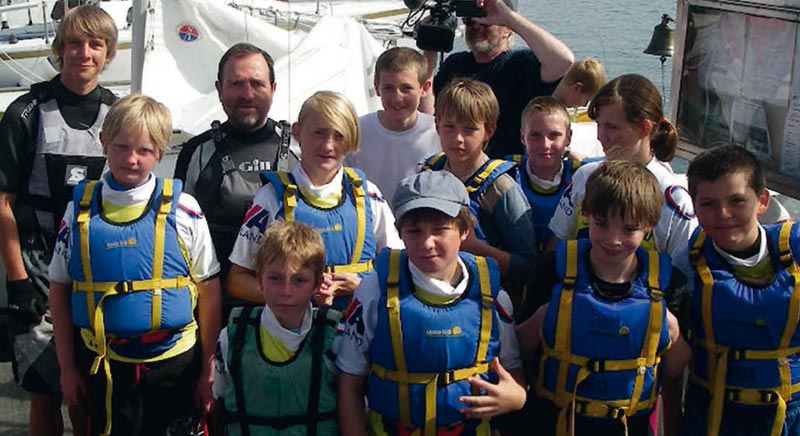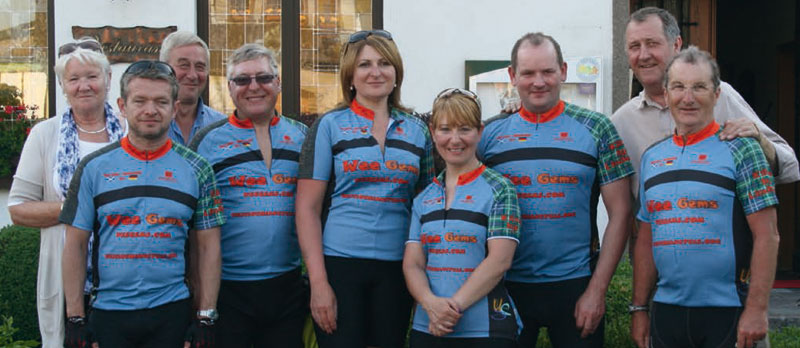Content
The Hochsauerlandkreis – West Lothian Partnership turns 40
by Dr. Karl Schneider, Hochsauerlandkreis District Administrator

The partnership between the Hochsauerlandkreis and West Lothian has been a living bridge for the population of both districts for 40 years now. Many driving forces on both the German and the Scottish side have succeeded in bringing the people of both districts together. They took many initiatives, most especially in youth care, sports and culture. Many thanks for that in this place!
The partnership came into life in 1972, first between the Arnsberg District and the County of West Lothian, and after area reforms on both sides between the legal successors, the Hochsauer landkreis and the West Lothian District. The friendship is especially supported by the partnership unions West LothianHochsauerlandkreis in Germany and the Twinning Association in Scotland that organize the annual visits by the help of committed members and cultivate close friendships – just as the founders have wished 40 years ago.
Looking back, the partnership is a practiced international understanding that has given birth to many personal friendships with, no doubt, many others to come. People of all ages have taken advantage of the partnership to know the country and its people in Scotland and in Sauerland respectively. They have always been hosted in a cordial way and the tours have left unforgettable impressions and become incentives for many of these people to visit their friends again.
I am sure that this living friendship will also continue in the coming decades. The Hochsauerlandkreis will be happy to contribute to this. Together we will be able to find more and more new driving forces for this successful partnership by the help of the two very committed partnership unions.
Long live the Partnerschaft
by Tom Kerr, Provost of the Council West Lothian Council
 The Twinning Relationship between West Lothian Council and Hochsauerland has been one of the most successful relationships between two authorities.
The Twinning Relationship between West Lothian Council and Hochsauerland has been one of the most successful relationships between two authorities.
I congratulate everyone who has been involved, both the Council and the Twinning Association for sustaining this Partnerschaft.
It has been a pleasure over the last 20 years as a Councillor in West Lothian and also the last 5 years as Provost to have been involved in this relationship.
It has nurtured relationships between Hochsauerland and West Lothian and I am sure that this will grow and be sustained for many years to come.
Long live the Partnerschaft.
40 Years of Understanding and Friendship
by Erhard Schäfer, Chairman of the Partnerschaftsvereinigung West Lothian – Hochsauerlandkreis e. V.
 Encouraging contact and bringing people together – this is the idea of our partnership. In 1972 the District of West Lothian and the Kreis Arnberg agreed to enter into a partnership. 40 years of partnership: This has created a connection between German and Scottish people – between West Lothian and the Hochsauerlandkreis and has led to a deeper understanding of each other. What we take for granted today, started off as an initiative of a few who dared to enter virgin territory.
Encouraging contact and bringing people together – this is the idea of our partnership. In 1972 the District of West Lothian and the Kreis Arnberg agreed to enter into a partnership. 40 years of partnership: This has created a connection between German and Scottish people – between West Lothian and the Hochsauerlandkreis and has led to a deeper understanding of each other. What we take for granted today, started off as an initiative of a few who dared to enter virgin territory.
What were the goals of the founding fathers of our association? This is what it says in our articles of association:
- Establishing and maintaining friendly relations.
- Striving for mutual understanding and respect for each other.
- Encouraging youth clubs, adult associations, and the entire population of both districts to get in touch with each other and to exchange visits, in order to develop personal and cultural relations, and to establish a foundation of respect and friendship between the people of West Lothian and the Hochsauerlandkreis, which will last for all times.
The former President of the Federal Republic of Germany Richard von Weizsäcker once said:“Friendship cannot be forced – it has to grow”. Partnership means looking at others with different eyes and entering their world, unconditionally and unprejudiced. Partnership means taking seriously what is serious to others and being able to laugh at what they laugh. Partnership means listening to the opinions and judgements of others and accepting them even if they do not correspond to one`s own values. Today our partnership is deeply rooted in the awareness of the people of both associations. 40 years of activity, in particular numerous exchange visits and cultural cooperation, have contributed to reaching this goal.
It has encouraged and supported exchanges and taught us a lot:
- Where there is exchange, understanding develops.
- Where there is understanding, friendship develops.
- Where there is friendship, peace prevails.
I would like to thank you for all your efforts and your commitment. May the future of the partnership between the Council West Lothian and the Hochsauerlandkreis be as exciting and succesful as in the past.
40 Years of Partnership
 by John McGinty, Leader of the West Lothian Council
by John McGinty, Leader of the West Lothian Council
As the new Leader of West Lothian Council I would like to wish the Partnership continued success and I am very much looking forward to meeting the delegation from Hochsauerland in September when we will mark the 40 years of partnership between our two areas.
The Friendship
by Graham Hope, Chief Executive West Lothian Council
 Since taking up the position of Chief Executive with West Lothian Council I have become aware of the very successful link between our two regions and I look forward to the opportunity of building on the signifcant accomplishments of the last 40 years.
Since taking up the position of Chief Executive with West Lothian Council I have become aware of the very successful link between our two regions and I look forward to the opportunity of building on the signifcant accomplishments of the last 40 years.
This year alone around 600 individuals from both regions and of all ages will participate in exchange visits between our two countries. These exchanges not only promote a better understanding of our two cultures but in many cases lead to lasting and durable friendships.
Last year I was fortunate enough to meet some members of the Partnerschaft during their 2011 visit to Scotland and in this special 40th anniversary year I look forward once again to welcoming them and members of the offcial delegation to West Lothian.
I wish the twinning link every success in the future.
Partnership Exchange Visits between Hochsauerland and West Lothian
by Liz Liddell, Chair West Lothian Twinning Association
 Since joining the Twinning Association 30 years ago my husband Dennis and I have made many visits with the partnership to HSK. Initially as part of the group with our daughters, Rachael and Rhona, in the 80s’and 90s’ and then as group leader when I became Chair of the West Lothian Twinning in 2002.
Since joining the Twinning Association 30 years ago my husband Dennis and I have made many visits with the partnership to HSK. Initially as part of the group with our daughters, Rachael and Rhona, in the 80s’and 90s’ and then as group leader when I became Chair of the West Lothian Twinning in 2002.
We in the Twinning Association have many fond memories of visits from the HSK Partnerschaft to West Lothian. During the previous 40 years we have made many trips with groups to different parts of Scotland including, St Andrews’s, Perth, Glasgow, Stirling, the Trossachs, Falkirk, Edinburgh and the Scottish Parliament, the Borders, sailing trips on Loch Lomond and the Forth, visits to museums and Whisky distillers, walking on the beach in Ayr, North Berwick and Dunbar, barbeques at Beecraigs and Laetare in Linlithgow, and evenings enjoying Scottish and German music…the list goes on.
Visits from West Lothian twinning to HSK are always enjoyable, we have stayed in and visited so many different places including Langscheid, Sundern, Meschede, Arnsberg, the toboggan run at Winterberg, the Jägerfest in Neheim, the Schützenfest at Brilon, visiting Worbis and Weimar, just after the opening of the wall, barbeques in the woods, concerts, and lots of musical evenings. Not to mention the cities of Düsseldorf, Köln, Dortmund, Münster, and sailing on the Möhnesee. Again the list goes on.
However, by far the most important aspect of the relationship between our two organisations is the willingness and dedication of its members. The friends we have made, the warmth, friendship and generosity shown to us is what makes twinning work. I am sure back in 1972 when the partnership was first formed nobody could have envisaged how successful it would become. Thousands of people, mostly youngsters, have had the opportunity to experience for themselves the diverse and rich cultures of both countries. I am sure the partnership will continue to grow and fourish in the years to come.
Founding History
by Wilfried Gundel
In July 1971, Willi Odenthal, director of the Kreisvolkshochschule, went to Scotland for vacation. Willi was very impressed with the journey into the north of Great Britain and it also leads him to West Lothian. A ‘new town’ had recently been developed there called Livingston. A town build from small villages but in a region chosen for economic development. Willi Oldenthal made first contact there with offcials from the local administration. And this was by chance. He was going with his caravan, when an engine error occurred. So he went to West Lothian County Council, in Linlithgow, and knocked on the culture department’s door. And there he received help: the engine started working again – as well as the drive for the partnership.
In May 1972, a Scottish delegation visited Arnsberg, in August of the same year, a delegation from Hochsauerland travelled to Scotland. And still in August 1972, the representatives of the Scottish West Lothian Council and the Kreis Arnsberg signed the partnership certifcate. A few years later, some restructurings gave the partnership a “new home”: there it was the West Lothian District, here the Hochsauerlandkreis; in the 90s the restructuring into Councils followed. “The aim of the partnership is to make meetings between the people of both districts possible, most especially between the youth, for the understanding of the people and the European unifcation.” This certifed main statement called for full commitment, most especially in the first years of the partnership between West Lothian and the Kreis Arnsberg.
In the first years, mostly organizational cliffs were to be sailed through in order to fulfll the aim of contacts, partnership. Rudolf Brüschke that has been working on building up and following the GermanScottish friendship in the Arnsberg District Administration, did not forget which organizational problems had to be mastered in order to organize visits etc. – even after 40 years. There have been several disturbances concerning the telephone. The telefax then eased the tasks, the communication, a little bit. And furthermore, the communication per letter did not want to work at first due to a strike.
Egon Mühr, the Arnsberg Kreisdirektor and later Hochsauerlandkreis Kreisdirektor and Oberkreisdirektor, and John Calder, the West Lothian Oberkreisdirektor (and later Head of the West Lothian Twinning Association until 1987, followed by Godfrey Fairbairn), were very committed. They stand for many years of responsible strengthening of the partnership. This is also what Egon Mühr, after having taken the lead of the Hochsauerlandkreis partnership organization in 1993, underlines in his memories at the 20th anniversary of the cooperation: “The little tree of partnership has developed to a strong, large tree that is continually growing new, strong branches. And for supporting the growth in West Lothian and Sauerland, the Distirct Council and the Kreistag were happy to give the necessary annual fnancial injections.” For his achievements in the area of the GermanScottish friendship, John Calder was awarded the “Bundesverdienstkreuz am Bande” in 1983.
The motor of the German-Scottish partnership keeps going and going. In the course of time, the motor was ready for switching to automatic operation. The regular contacts have become a pleasant matter of course. Automatically, the milestone anniversaries of the partnership are celebrated twice. For this reason, in the year of the 20th anniversary about 850 friends of the partnership travelled back and forth between the two districts.
But actually, every year is worth celebrating, when taking the active exchanges between the two regions into account. In the first years, the exchange visits left their mark on the partnership – and with time passing, more and more contacts between clubs, organizations and people came to life.
This “anniversary book” for the 40th anniversary is mainly meant to provide an insight into former times, but also into the meetings today.
🛈 It is almost natural, that the first groups of visitors from West Lothian stayed in the Volkshochschule in Langenscheid, being the working home of the VHS director Willi Odenthal. But soon, our Scottish friends asked for more possibilities to shop or go out. Therefore for the next visitors, the “Haus Sonnen-schein” was chosen. It was brought down a long time ago already: today, there is a nursery school located in that place at the “Neheimer Berg”.
Youth Exchange
by Wilfried Gundel
In the year after signing the partnership certifcate, one of its main features, meeting each other, was already realized – by the Kreis Arnsberg Jugendamt (youth welfare offce). Willi Odenthal, the one that has “found” West Lothian, started organizing a youth meeting together with the Kreis Arnsberg Kreisjugendpfeger Konrad Garske. The response to the offer to participate was large: about 40 young people registered for the journey. “For a journey into the unknown, in every meaning of the word”, Konrad Garske remembers.

This group of youngsters went to Scotland with the Kreisjugendpfleger Konrad Garske (first row) in 1987. It was the last international youth meeting in West Lothian directed by the Kreisjugendpfleger.
By bus to Rotterdam, by ship to Hull and on by bus to Livingston. This travel system for going and coming back is being followed since the first journey in 1973. For the first years, John Calder was the most important local contact person – he also had organized a program for the young visitors. At first, the Sauerland guests were staying in a farmer school, in the later years in a motortechnology school (Motec) in Livingston.
After the foundation of the Hochsauerlandkreis, Scotland was still a special area of work for the Kreisjugendpfeger Konra Garske, whose offce was in Meschede now. “Garske is Scotland” is what people were saying about him after some years within the administration, among the youth and in Scotland as well. He continued this work until 1987.
Before the journeys, the youngsters were and are being invited to a preparative meeting. And this was really necessary, most especially in the first years, as Konrad Garske remembers smiling. This was because many youngsters had a wrong image about the destination of the journey: Scotland. That the participants had a completely different image is what came out during the meetings after the journey. These meetings were held on a voluntary basis, but it was always almost all participants coming to see each other there again. And it was really nice to remember the many trips, to talk about the invitation of the Stirling Councillor for food. Or to remember being at the worldwide known Tattoo military music festival in Edinburgh – also this year, when German military musicians entered the arena in the castle together with other “colleagues” for the first time.
All these years were infuenced by the infnite number of events and experiences. But the man from Meschede mostly remembers the journeys in the first years, the many contacts having come to existence. Although there was something that really needed special convincing talent at the beginning: The youngsters to stay in host families, even though it was for one night only.
The annual visit of a group of youngsters from Sauerland in Scotland being a fx part of the program, it still took some years before groups of youngsters from the partner council found their way to Sauerland. Inbetween, the Kreisjugendamt employees had an eye on other constellations already, as even scouts from Meschede travelled to Scotland (to the 10th anniversary of the partnership). The Wentholthausen St. Georg scouts travelled to Scotland in 1981 for the first time. In 1986, the young scouts even went for a threeweek Highland trip – here too, Konrad Garske supported the scouts in planning. And youngsters from the Meschede Kolpingfamilie joined the travelers at a Kreisjugendamt journey.
This meeting in 1986 with more than 50 young people is one of the special highlights in the book of the impressive meeting history. The Scottish hosts had really suffered to organize an informative and enjoyable program for such a big group of visitors – which culminated in a goodbye party with potato salad and Sauerland sausages. At this occasion, the leaders of the Sauerland group presented a coat of arms plate to John Calder.
Many contacts have developed from these meetings. Some of the (former) young Sauerland participants bring the memories of the Scotland journey back to life in a special way: They contacted the Kreisjugendamt as parents, remembering their great time in and around the Highlands and wanting to register their children for a journey to Scotland.
And this should be no problem: The Kreisjugendamt still organizes annual youth meeting journeys to West Lothian.
🛈 At one Scotland journey, there was a mishap in Rotterdam. After the youngsters and their companions have entered the ship, Konrad Garske, who would normally take care of the quarters of the travelers during the first hours on the ship, went to the deck again an looked back to the port. And there he saw the Sauerland bus that was supposed to be on the ship, too. The journey organizer turned to a mate and then to the captain of the ship, communicating the problem. “I was begging the captain to go back to the landing place.” Finally the captain was convinced and berthed one more time, so that the travelers from Sauerland could welcome their bus with the driver on board.
Newland Concert Brass – Fanfaren-Korps Neheim-Hüsten e. V.
by Klaus Alteköster
It began in 1988, when the FanfarenKorps Neheim-Hüsten was asked by the Hochsauerlandkreis whether they didn’t want to look after a Scottish brass band during their HSK visit in July. This happened after a Scotland visit of the FanfarenKorps in 1983 (to the Boghall Bathgate Pipe Band) and their Scotland tour in June 1988. Being excited by the mentioned idea, the FanfarenKorps accompanied the Newland Concert Brass that has only been founded one year earlier during their stay in HSK and at the Möhnesee. They visited Cologne, the Lantern Festival in Eslohe, the Fort Fun adventure park and the Dortmund Westfalenpark. Close friendships between the members of the bands developed quickly and they contemplated on how the two ensembles can stay in touch with each other. The result was the decision to found a partnership between the Newland Concert Brass and the FanfarenKorps Neheim-Hüsten.
In the following year, 1989, a delegation of the FanfarenKorps board travelled to Bathgate for offcially signing the partnership certifcate. The formal signing took place in an offcial ceremony held in the Kaim Park Hotel. And before the end of the stay, a Fanfaren-Korps visit in Bathgate for the following year was agreed on. Therefore at Whitsun in 1990, the Neheim-Hüsteners travelled to Scotland for an 11day journey to cultivate the new partnership.
On the way back from Scotland, the FanfarenKorps still stopped in Remscheid-Lennep to participate in the Schützenfest (German marksmen’s festival) parade. In 1991, the Scottish musicians visited Neheim again and in 1994, the FanfarenKorps participated once more in the Bathgate Procession that traditionally takes place in June. During this visit, they also viewed the Edradour Distillery and Pitlochry, and the new friendships were strengthened furthermore. In the years 1995 and 1998, the Newland Concert Brass visited Neheim to participate in their Schützenfest and Jägerfest respectively. In between, in 1996, a delegation of the Scottish brass band came for the 40th anniversary of the FanfarenKorps and in 1997, the musicians from Neheim-Hüsten fied to Scotland again, in order to participate in the Bathgate Procession.
After a Newland Concert Brass visit in 2004, a delegation of the Scottish band participated in the 3-day festivities in connection with the 50th anniversary of the Neheim-Hüsten Fanfaren-Korps in 2006. In the year 2008, the Fanfaren-Korps went to Scotland again, not only to musically participate in the 150th Bathgate Procession, but also to participate in a parade in Torphichen. Furthermore, the musicians visited Edinburgh and Sterling during their stay. Two years later, in July 2010, the Newland Concert Brass came again to Neheim for a oneweek visit. Their program comprised the musical participation in the Schützenfest in Bergheim, a concert in the Fort Fun adventure park and a park visit, a trip to Cologne and a tour of the Borussia Dortmund football stadium. Therefore the Fanfaren-Korps Neheim-Hüsten and the Newland Concert Brass are united by a deep over-20-years friendship, which both bands are very proud of.
The Herdringen music band
by Werner Schulte
Where do the Scots party? On New Year’s Eve on the long Princess Street in Edinburgh? Sure! Or after winning England in football in the worldwideknown Hampden Park Stadion in Glasgow? Yes, of course! But on 15th July 2011, the Royal Burgh of Linlithgow Reed Band from the land of kilts, checks and whisky, that is known in Sauerland through different concerts, also had fun on the “Schützenplatz” in Herdringen.

The musicians from Linlithgow, a city rich in traditions in the Scottish partner district of the Hochsauerlandkreis, visited the beautiful Sauerland for the ffth time. The first Reed Band visit was in summer 1981, the year of the band’s 25th anniversary. Further Hochsauerland visits followed in 1985, 1989 and 2008. Here, the Reed Band played at the Herdringen Osterfeuer at a very cold temperature.
Unfortunately, it was only once that the Herdringen music band had the chance to know the beautiful Scottish landscape and the Scottish hospitality, which was in 1997. What the participants will not forget are the happenings at the Highland Games. Currently, we are planning another visit within the next two to three years.
In 2011, the musicians visited Sauerland from 8th to 18th July, together with family members and friends. The big 55-people group stayed in the Landhotel Dietzel in Herdringen and drove out the springlike cold weather. The youngest of the Scottish musicians was the 9-yearold Peter Molloy from the youth orchestra, the oldest one the 80-year-old Eddie McKenna, one of the cofounders of the band.
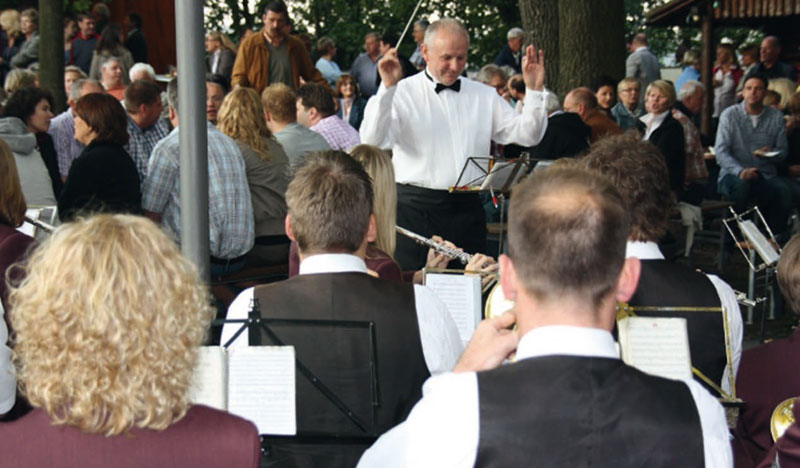
The motto being a German-Scottish evening, the Herdringen music band invited the Linlithgow Reed Band visitors for a Dämmerschoppen (sundowner). Densely packed and enjoying a lot of music from both bands, the visitors and friends of the partnership formed a real crowd in the yard of the local Schützenhalle. Even days after the event, the musicians were asked for an annual repetition of this event. It would be a very good opening of the wellknown Schützenfest season in the Hochsauerlandkreis.
And of course, with the great atmosphere, music played by both bands, under the trees of the very nicely designed Schützenhof, an original Scottish whisky was not to be missed. This traditional drink was offered to all visitors together with a selfbaked traditional Clottie Dumpling. Until night, the Scottish and German musicians were celebrating together with friends of the partnership from the entire HSK and the many Dämmerschoppen visitors.
The world language of music, the notes that can be read in any country without language problems and that are naturally transformed into sound through the instruments – this is what brought both bands together. We like remembering the piece “The Rose of Kelvingrove”.
Looking back at the Reed Band visit in Herdringen, that is a part of Arnsberg with over 4000 inhabitants, the Herdringen music band will play this piece of music at the next musical request programme on 24th march 2012. “We like remembering the visit and hope to be able to visit the Reed Band and the West Lothian region soon.”
For further information on the German-Scottish evening, please visit the homepage of the music band and www.musikverein-herdringen.de.
An unusual trip to Scotland
by Gabriele Schüttelhöfer
Since 1979 there was a pupil´s exchange between Realschule Hüsten and Deans Community High School, Livingston. This exchange was part of the partnership between the Hochsauerlandkreis and the West Lothian Council. Every two years pupils of Hüsten were guests in Deans and Scottish pupils stayed in Hüsten. Usually the young people and their teachers were guests in German or in Scottish families.
So 35 pupils and 4 teachers of Realschule Hüsten went to Scotland in June 1989 and they all stayed with families in Livingston. Many of these pupils never forgot their visit and it came back into their minds whenever they remembered their schooldays. One of them was Miriam Wilke.
20 years later in 2009 she tried to fnd her former classmates and their Scottish partners. Ten of them soon decided to go back to Scotland as an anniversary trip. The HSK helped to contact the school in Livingston.
n Wednesday June 17th; 2009 nine former pupils of Realschule Hüsten and one of the teachers and her husband set off to Edinburgh where they were welcomed by Mr. Gordon Connolly a representative of the West Lothian Council.The following 5 days became an extraordinary event for all who were members of the party.
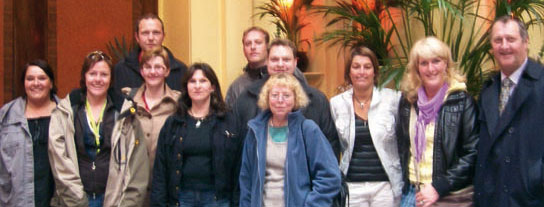
Participants “Jubilieetrip” 2009. In the middle: teacher Gabriele Schüttelhöfer, right: Gordon Connolly, Community Facilities Manager West Lothian
On the first day the visit to Deans Community High School took place. Although there was the removal into a new school building ahead of the staff the German guests were welcomed heartily. The visitors could take part in some lessons and have a look at the rooms they could remember so well from their first visit 20 years ago. But they also noticed changes: the pupils of Deans now wore school uniforms.
The guests also visited Edinburgh, Mill Farm, Glasgow, Stirling Linlithgow Queensferry and Rosslyn Chapel. Some places they had seen already 20 years before, some were new to them.
This trip was a fne experience for all members of the party and they felt that they were very welcome in West Lothian: at the school, in the community. They all agreed: this wasn´t their last visit to this hospitable country, they would all come back.
A truly well-rounded thing: the contact between the TuS Medebach and West Lothian
by Josef Drilling
It was in 1979 that through the Hochsauerlandkreis the TuS Medebach (Medebach sports club) got in touch with the Scottish partner council West Lothian for the first time: The under19 TuS football team visited the Queensferry High School. There were three football matches carried out with little chance of success for the HSK team. But this did not affect the new friendship with this school: one year later, the High School team came to Medebach and played the opening match at the inauguration of the new feld.
Until 1999, the TuS Medebach partnership was carried out annually and in turns in Scotland and Medebach. On the German side, it was youngsters from Medebach, Hallenberg, Winterberg, Worbis, Solingen and Kamen participating. On both sides, the stay was always organized in families – a proven method, as the participants could personally experience the live of the families that were still much less demanding than in Germany. A total of about 1000 youngsters and adults have participated in the meetings. The schools contacted are in Queensferry, Blackburn, Bathgate and Livingston.
For learning something about Scotland, many trips were organized: to St. Andrews, Stirling (main residence of the Stuarts), Fort William, Edinburgh, Oban, Loch Ness, Aberdeen, Balmorel, Irvine, Inverness, Glasgow and to many other places and sights. On the German side, the organization of these trips was mainly done by Josef and Marlies Drilling, and at the beginning by Franz Wolf, while in Scotland it was Godfrey and Jean Fairbairn organizing them and joining their children on the travels to Medebach as well. The bus drivers were Bernd Hellwig, Klaus Müller and Ulrich Hellwig.
Numerous events have been visited, e.g. the Highland Games, Tattoo Edinburgh, school events and evening meetings with folk music. From Medebach, the guests were offered trips to the surrounding area as well as to Kassel, Köln, Worbis, Stukenbrock and the Loreley. A trip to the then East German Border (GDR) has made a strong impression. The Scots were astonished and deeply touched, as they had never seen something like this in Europe. It was absolutely quiet in the bus.
Many contacts are still kept up until this day, be it by letter, phone, email or through personal visits. In 2009, a group of eight people travelled to Scotland. In October 2011, Godfrey and Jean visited Medebach along with their son and their daughter in law.
At the celebration of the 40th anniversary of our partnership in 2012, we from the TuS Medebach can only report positive things. The Scotland visits have been impressive – not only for the youngsters. Also the social differences that were noticeable at the beginning of the partnership in comparison to Germany were very instructive for our youngsters. The great Scottish hospitality remains unforgettable.
Blackburn Academy – Medebach Exchange
by Godfrey Fairbairn
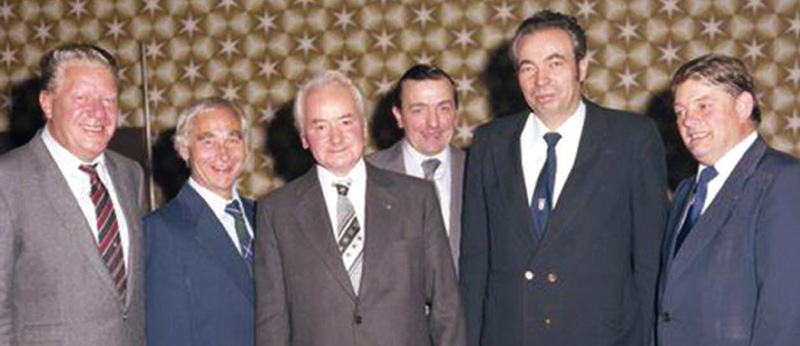
In the year Scottish swimmers came to Medebach for the first time, John Calder celebrated his 65th birthday
In 1978, a group of young footballers from the Sports Club of Medebach visited South Queensferry High School. They slept on the foor of the school gymnasium. The party was led by Josef (Jupp) Drilling and Bernd Hellwig. When I went to welcome them on behalf of the Twinning Association, it quickly became clear that there was great enthusiasm for an exchange on the German side, but they still lacked a long term partner in West Lothian.
In the following year, the swimming club of Blackburn Academy approached me with a view to setting up a link within the HSK. One thing led to another and in the Summer of 1979, I accompanied a party of young swimmers to Medebach, the visit being hosted by the town’s Sports Club (TuS).
It was decided then that the exchange should be placed on a reciprocal basis, with the young people being accommodated in host families. Much credit goes to the parents of Blackburn Academy pupils for their unstinting hospitality and innovative fundraising.
With the opening of the James Young High School in 1982 and the massive reduction in size of Blackburn Academy, the organisation of the exchange transferred to the new school, together with many of the staff, myself included.
Over the next twenty years, the exchange continued to be popular, with wide and varied programmes being organised on both sides. In that time it is estimated that some 1500 young people visited West Lothian and Medebach. To this day, I still hear of contacts established in those years being continued to the present day.
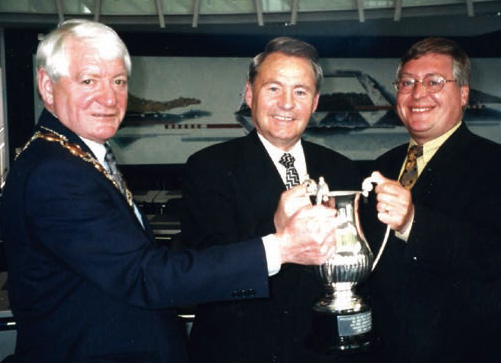
Provost Joe Thomas and Chief Executive Alex Linkston presents the “Loving Cup” of the West Lothian Council to Provost Franz-Josef Leikop, June 2000
Many party leaders on both sides (Jupp Drilling deserves a special mention in this regard) gave freely of their time – the visits always took place during the Summer holidays. Many parents also assisted in all sorts of ways – helping with barbecues, farewell parties, arranging visits and so on. A tower of strength in all this was the late Forsyth Jamieson and his wife Margaret who could not do enough to help, whether privately or at the Mill Farm (Livingston Heritage Centre).
The exchange was wound up in the late nineties, making it one of the longest lasting and successful schemes in the history of the Twinning Association, with echoes continuing to the present day.
Voßwinkel wind band and the “Royal Burgh of Linlithgow Reed Band”
by Ulrich Wilmes

The image shows the Linlithgow Reed Band and the Voßwinkel wind band musicians making music together during the Schützenfest in Bachum in July 2011.
The contacts came to exist thanks to our musical comrade and Vice Head Günter Nies, that unfortunately died much too early. He had visited the Scottish partner district several times with school classes before. During our visits in West Lothian we could convince ourselves that all stories and jokes about the “Scottish greed” are not true. Rather the opposite: the friendliness, helpfulness and hospitality of the Scots were impressive. In 1989, 1992 and 1997, our Voßwinkel wind band visited Linlithgow. In no time, connections to the local Reed Band have been made. We had common rehearsals and events in Scotland as well as in Hochsauerlandkreis during the Reed Band visits in Germany. It is mainly the two Reed Band members Edgar Liddle and Murdoch Kennedy that are to thank for that the contacts are still kept up until this day.
Linlithgow Reed Band’s links with Germany
by Murdoch Kennedy
 Music is the international language which knows no boundaries. It has been a major cornerstone of the twinning link between West Lothian and Hochsauerlandkreis, involving a whole range of organisations, from school bands to full orchestras.
Music is the international language which knows no boundaries. It has been a major cornerstone of the twinning link between West Lothian and Hochsauerlandkreis, involving a whole range of organisations, from school bands to full orchestras.
The Royal Burgh of Linlithgow Reed Band has made fve trips to Hochsauerlandkreis since 1981 and has established close links with many of the local bands there. They have also provided hospitality for visiting musicians to West Lothian.
A great exchange of music and ideas has taken place and the extensive Reed Band library contains many German musical pieces which have been swapped for wellknown Scottish marches. Individual band members have travelled to Germany to play with local bands at the summer Schützenfests and in 2009, Carsten Freitag from Neheim played with the Reed Band at the historic Riding of the Linlithgow Marches.
The band made its first trip to Germany in the summer of 1981, at the time of its 25th anniversary, and spent ten days at the Gasthof Wrede in Oeventrop. This would also be the band’s base for subsequent trips in 1985 and 1989. A short Easter visit took place in 2008, with the band being housed in the Hotel Dietzel in Herdringen. This allowed the Linlithgow musicians the chance to renew their friendship with the local Musikverein, whom they first met in Scotland in 1997. In 2011, a 55strong party spent ten days in Hochsauerlandkreis and from their base in Herdringen, they undertook an extensive programme, including visits to Fort Fun, the Veltins brewery and the Borussia Dortmund stadium and a joint concert and social evening with the Musikverein Herdringen. The Reed Band also renewed their association with the Schützenfests in Niedereimer and Holzen. Making their third visit to the Schützenfest in Bachum, the band played together with the Musikverein Voßwinkel, who had visited Linlithgow on three occasions.
Linlithgow Reed Band has strong bonds of friendship with musicians in Hochsauerlandkreis and long may this continue!
Partnership West Lothian District – Hochsauerlandkreis
by Jürgen Wagner
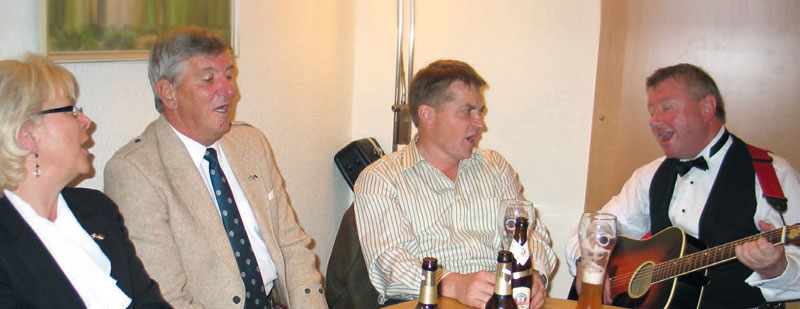 In the development of a really European society, partnerships like the one between West Lothian and Hochsauerland play an essential role. It is through music, that a Europe of the people comes to exist locally step by step. To keep the partnership alive and to maintain it, much commitment, enthusiasm and work is needed.
In the development of a really European society, partnerships like the one between West Lothian and Hochsauerland play an essential role. It is through music, that a Europe of the people comes to exist locally step by step. To keep the partnership alive and to maintain it, much commitment, enthusiasm and work is needed.
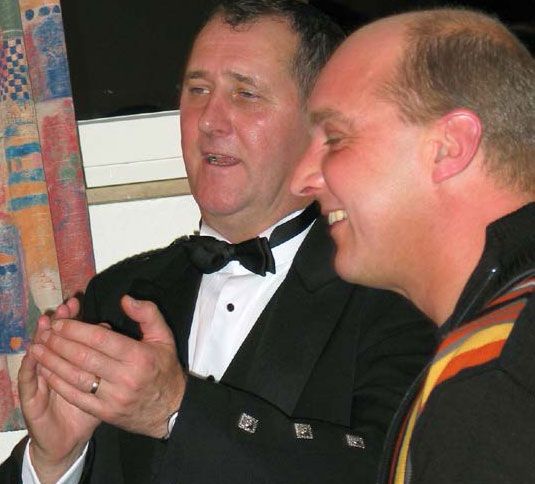 Thanks to a musical event in March 2002, when the church wind choir Gleidorf played together with a musical delegation from West Lothian, numerous personal and human contacts have developed. The intense talks were deepened the following day already, at a private meeting in the “earlysummer” garden. This is how the participants learned common things and differences from each other, together with feelings and prejudices and preferences and dislikes as well. Shortly said: everybody tested the other one’s way of being.
Thanks to a musical event in March 2002, when the church wind choir Gleidorf played together with a musical delegation from West Lothian, numerous personal and human contacts have developed. The intense talks were deepened the following day already, at a private meeting in the “earlysummer” garden. This is how the participants learned common things and differences from each other, together with feelings and prejudices and preferences and dislikes as well. Shortly said: everybody tested the other one’s way of being.
These contacts have been intensifed by both sides and considerably deepened as the years went by. Private visits in Scotland and Gleidorf respectively, school exchanges, changing of houses during holidays and giving support in the search for a Headgreenkeeper have lead to a good knowledge of each other and respecting the other one’s way of the life and attitude. Concerts of the Scottish bands in the Gleidorf church lead to an extraordinary support by the Scottish friends and fnally resulted in the installation of the “Gleidorf Music Festival”.
 Being impressed by the extraordinary commitment for building a new village centre through a village park and by the generosity of farmer Teipel, who put the space at our disposal, the West Lothian District was considerably involved in shaping the opening ceremony. Together with the Gleidorf church wind choir, the West Lothian Jazz band and a Piper delegation, the event was well celebrated with about 800 guests. The event caused great emotions. Both sides agreed, that the Gleidorf Festival should be repeated once in two years. By now, the 4th Gleidorf Open Air Festival has taken place already. Thanks to private sponsors, the West Lothian District and the Hochsauerlandkreis, it has always been with free entrance for the citizens of the Schmallenberg area. The gain from it is a deep friendship and understanding between the Scottish musicians and the German participants.
Being impressed by the extraordinary commitment for building a new village centre through a village park and by the generosity of farmer Teipel, who put the space at our disposal, the West Lothian District was considerably involved in shaping the opening ceremony. Together with the Gleidorf church wind choir, the West Lothian Jazz band and a Piper delegation, the event was well celebrated with about 800 guests. The event caused great emotions. Both sides agreed, that the Gleidorf Festival should be repeated once in two years. By now, the 4th Gleidorf Open Air Festival has taken place already. Thanks to private sponsors, the West Lothian District and the Hochsauerlandkreis, it has always been with free entrance for the citizens of the Schmallenberg area. The gain from it is a deep friendship and understanding between the Scottish musicians and the German participants.
In connection with this partnership, we wish that, especially between the youth, there will be a vivid exchange and personal and human contacts will develop.
Realschule Eslohe – journeys of the gratuating classes
by Wilfried Gundel
“Eslohes Secondary Modern School und St. Margaret’s Academy – a Catholic comprehensive school in Livingston – are currently developing relationships within the framework of the twinning.” This is what was to be read in the newsletter of the school in Livingston in November 1996 – one year before the first graduating class from the Realschule Eslohe travelled to Scotland to the partner district West Lothian.
It was in 1996, that the first contacts between both school have been made. This happened after the Eslohe school had cancelled a connection from the years before with a London school. After that, the pupils could choose a new travel target. “I voted for Scotland because I thought that You normally don’t get there, as it is so far”, a young woman remembered last autumn at a meeting of former class members in Eslohe.
And so it came, that their English teacher Horst Vielhaber and his wife Helga made a private information journey to West Lothian in 1996. The contact with the St. Margaret’s Academy teacher in charge of foreign languages James Forbes had already been existing.
🛈 It is mainly the small things the young women remembered meeting again in autumn last year. E.g. that it was a great secret to be lifted what the Scots wear under the kilt. During an Edinburgh Castle visit, one of the pupils came creeping up to a guard and kneeled down to unveil the secret. “But it didn’t work.” The guard left his post.
From 8th to 14th of May 1997, the first Eslohe visit in Livingston was to take place. Many personal, written and phone agreements between teachers, the Culture Offce of the district and the local partnership organization had been made in advance. The pupils had prepared themselves for the journey during the lessons.
And by bus, ship and bus again, the graduating class (10a) from the Realschule Eslohe, accompanied by the teachers Karola Bösing and Horst Vielhaber, traveled to the youth hostel in Linlithgow, where they were welcomed by Headmaster A.J. Gavin, Kathy McGrath, James Forbes and Godfrey Fairbairn (from the Twinning Association) – welcomed to a very exciting and interesting premiere with joint trips with Scottish pupils and many other meetings.
While in the following year the school from Livingston sent a group of pupils for a return visit to Eslohe in Sauerland, two other graduating classes from Eslohe visited the partner district West Lothian (in 1998 and 2000). Every time awaited with excitement, the project was not exactly cheap: The journey cost 500 Deutsche Mark, pocket money not included.
Talking about money: one of the pupils had lost her purse during a church visit. She went back to the church and turned to the sexton with her problem. He had found the purse and asked the young girl from Eslohe to describe it for him. “It was really diffcult, as I needed words I didn’t know yet”, she remembers. But there was a happy ending.
As things are now, there might be another journey to West Lothian for Eslohe Realschule pupils in this anniversary year. Last year, the teacher Huberta Eickhoff travelled to Scotland with a group of people from the Partnerschaftsvereinigung – not only to get impressed by the country, but also to prepare a graduating class trip for 2012.
Sports Links between Hochsauerland and West Lothian
von Charlie Raeburn
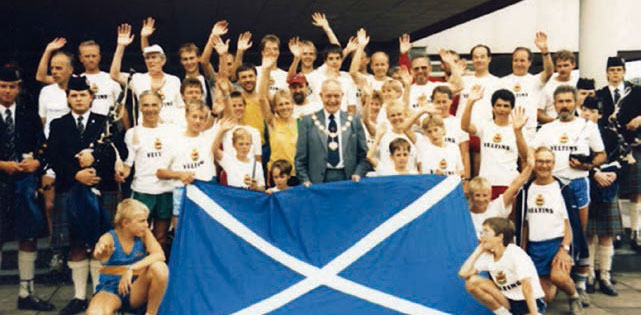
8th august 1986; 40 german athletics reached the end of their 1,000 run from Hochsauerland when they were officially welcomed to West Lothian with a civic reception in council headquarters by district council convener Dominic Mc Cauley
On a visit to West Lothian in September 2004, Herr Winfried Stork (CEO Hochauerlandkreis) invited Charlie Raeburn (Sport and Recreation Manager, West Lothian Council) to visit Germany in December 2004, to discuss possible future sports links between Hochsauerland and West Lothian.
The first venture was a weekend study tour by a small delega-tion of offcers from both West Lothian Council and from sportscotland undertook a detailed tour of Hochsauerland in June 2005 Issues and practices considered included:
- Participation issues for sport and physical activity;
- Community Sports Clubs
- Access to school facilities by sports clubs
- Coach Education
- Potential links for the future of HSK/WLC sporting links.
As immediate actions from this visit:
- A study tour for a small delegation from Hochsauerland visited West Lothian in June 2006 to consider these sports options.
- West Lothian’s swimming clubs combined their efforts to participate in the annual SV Neptun “open ‘Internationales Schwimmfest’ being staged in the outdoor pool in ArnsbergNeheim from 25 June 2006.
Twenty five young swimmers aged 12-15 from the various West Lothian clubs, travelled to Germany with four swimming coaches and a team manager. Competing as West Lothian Swim Team, this first visit proved to be the catalyst for some very positive change amongst the seven clubs and the wider swimming community..
Although the group were only able to stay for two days of the competition, the positive experiences gained of the SV Neptun event, and in particular of combining the efforts and expertise of all seven clubs and Sarah Pryde of West Lothian Sport and Recreation Services to prepare and facilitate the trip has led to the establishment of what is now known as Swim West Lothian. The positive experiences shared by the swimmers, coaches and offcials in Germany marked a change in culture in West Lothian with the emergence of one vision, that through cooperation and cohesion West Lothian had the capacity to support professional coaching for the elite swimmers in West Lothian whilst still retaining the swimming clubs local roots and identities.
The subsequent visits of Swim West Lothian to participate in the SV Neptun meet in 2008, in 2010 and again in the 2011 demonstrated the improved quality of swimming abilities of the West Lothian swimming community. Having narrowly missed out on the Top Club award in 2010, Swim West Lothian were eager to make sure that this year we brought the trophy home to Scotland, competing with their largest squad to date; six Team Staff and 46 swimmers aged 11 to 17 years.
Swim West Lothian and SV Neptun are currently discussing the possibility of a visit to West Lothian in 2012. There are also considerations being discussed about improving the links between individual clubs of Hochsauerland and West Lothian and maybe also the Masters (veteran swimmers). It is also recognised that time needs to be found to extend the links beyond simply swimming competition to social and cultural experiences.
Possible future projects include:
1. Annual/Biannual event, which might involve a range of 5 sports or activities. These activities might rotate to allow clubs to develop their own links.
2. Joint projects – e.g. developing “diversionary activity” programmes for vulnerable youngsters.
3. Joint Seminars: Coach Education, Club Development, Walk Leaders.
Concerns clearly include the need to at least part fund some of these activities.
International Swimming Festival
by Astrid Schürmann/ SV Neptun
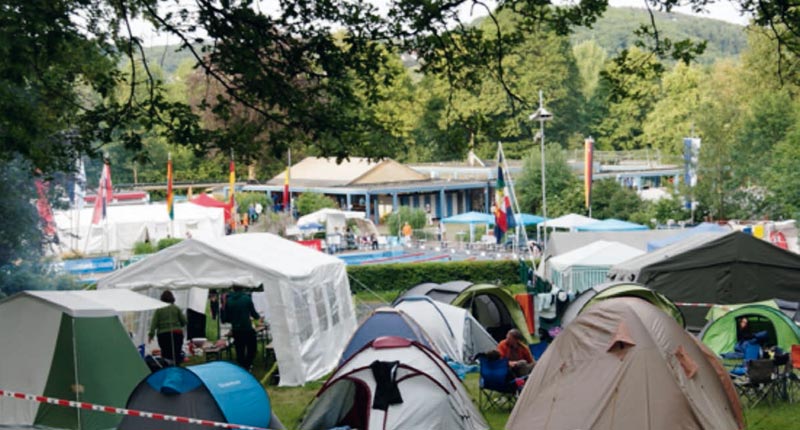 After the first offcial talks in September 2004, in June 2006 the time had finally come: In addition to the many meetings in the areas of music, school and education, the offcial visits and the youth exchanges between the Hochsauerland and the West Lothian Council, the relationship has been extended to the area of sports.
After the first offcial talks in September 2004, in June 2006 the time had finally come: In addition to the many meetings in the areas of music, school and education, the offcial visits and the youth exchanges between the Hochsauerland and the West Lothian Council, the relationship has been extended to the area of sports.
And so 25 young swimmers from the different clubs in West Lothian, aged between 12 and 15 years, travelled with five chaperons to the “International Swimming Festival” in Germany.
Every year on Whitsun weekend, the open air bath Neheim turns into an international competition site as the “International Swimming Festival” of the SV Neheim-Hüsten, which is one of the biggest ones of its kind in Germany, takes place there. When passing the open air bath Neheim on a Whitsun weekend, one may believe it’s a new camping site. Big and small tents are standing on each and every lawn within and around the bath area.
Since their first participation in 2006, the swimming team from West Lothian is a welcome guest in this event.
In 2010, 687 athletes from seven nations celebrated the Swimming Festival at an outstanding weather. Among these, there were 37 participants from West Lothian.
And at the 40th International Swimming Festival in 2011, all records have been broken. With 46 active participants (aged between 11 and 17 years), West Lothian provided the second largest swimming team after the SV Neptun in a feld of 45 teams with a total of 739 active participants. The team set three new track records. In the medals overview they received a total of 72 gold medals, 65 silver and 50 bronze medals.
“At home we only train in indoor swimming pools on 25-meter tracks (the open air bath has 50meter tracks), as there are only two open air baths in Scotland”, the team leaders Callum and Dannah reported. For the tournament, they had to get a release from school. “It is always an exhausting time, but we can also make many international friends”, Dannah underlines. Both team leaders noticed that their own team moved together through the journey and that the competition results are improving more and more. They also want to compete next year.
The relationships are to be deepened by a return invitation of the West Lothian Swimming Team. A visit of the SV Neptun in West Lothian is planned to take place in the year of the anniversary.
The Scots were here!
by Reinhard Bartsch
For years, the Hochsauerlandkreis has a lively exchange with its Scottish partner council West Lothian. Next to numerous cultural meetings, there were sport exchanges in football, golf and swimming. In 2008, the Scots asked whether and exchange in the area of sailing would be conceivable. And quickly, a link to the head of the Seglergemeinschaft Möhnesee Südufer (SMS – Möhnesee sailing community) Uli Papencordt has been set up, who works for the Hochsauerlandkreis as deputy head of the Kreismusikschule.
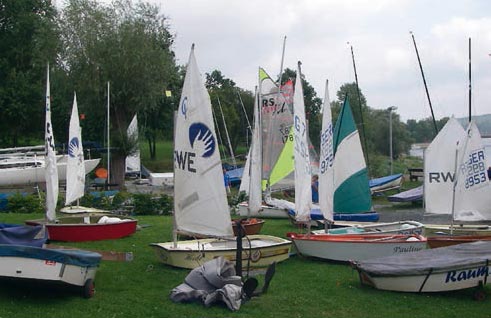 After a long time of preparation by Karin Rusche from YCWA, Uli Papencordt and youth offcer Reinhard Bartsch, the time has fnally come on 10th August 2009: the Scottish youngsters from West Lothian were on the way to the Möhnesee.
After a long time of preparation by Karin Rusche from YCWA, Uli Papencordt and youth offcer Reinhard Bartsch, the time has fnally come on 10th August 2009: the Scottish youngsters from West Lothian were on the way to the Möhnesee.
Ten youngsters from the RFCM were impatiently and somewhat uncertainly awaiting the arrival of the Scots. The youth offcer had many questions to answer: “Can they sail at all?” “Do we allow them on our boats?” “Are they perhaps going to wear kilts?” “How are we supposed to speak with them?” But the hosts were not completely unprepared! They had printed out the main sailing expressions in English from the internet, the dictionary was ready at hand. And: “We were hoping that the visitors would understand our English, but most especially that they wouldn’t speak a distinctive dialect.”
The tension was rising, and no sign of the „scotsmen and –girls” at 15 o’clock … Then we were informed that the Scots just reached the youth hostel and were moving into their rooms and that they would enjoy some coffee (or was it tea?) and cake after that. Shortly after 16 o’clock, they fnally came! Ten happy youngsters accompanied by their coach George and a camera man (yes, You read well, Chris was engaged to record the premiere on DVD), everybody ready in sailing clothes. A little uncertain, they entered the landing stage.
 The shyness at the greeting quickly gave way to the curiosity about the boats. And much faster than expected, the Scots and the hosting kids were sitting together on the RFCM youngster boats, looking forward to the first hitches at agreeable 3 Beaufort. Language problems? Not at all. The common base or language was sailing! After sailing for more than two hours, which were enough to break down all prejudices (as the Scottish kids can sail!), we had to get the boats ready for transport to the other side of the bridge. Quickly, the masts were folded down and the boats were taken in tow by two DLRG boats to the Yachtclub Westfalia Arnsberg. There we had a joint evening meal with the youngsters from the YCWA and the participants of the “OptiWoche” that was taking place at that time.
The shyness at the greeting quickly gave way to the curiosity about the boats. And much faster than expected, the Scots and the hosting kids were sitting together on the RFCM youngster boats, looking forward to the first hitches at agreeable 3 Beaufort. Language problems? Not at all. The common base or language was sailing! After sailing for more than two hours, which were enough to break down all prejudices (as the Scottish kids can sail!), we had to get the boats ready for transport to the other side of the bridge. Quickly, the masts were folded down and the boats were taken in tow by two DLRG boats to the Yachtclub Westfalia Arnsberg. There we had a joint evening meal with the youngsters from the YCWA and the participants of the “OptiWoche” that was taking place at that time.
After dinner, the „offcial” welcome followed, during which some basic rules for all participants of the sailing week to come were discussed. Then all participants received a bright blue tshirt with the inscription “Sailing – simply the best”. After the first contact and some games, the youngsters walked back to the youth hostel.
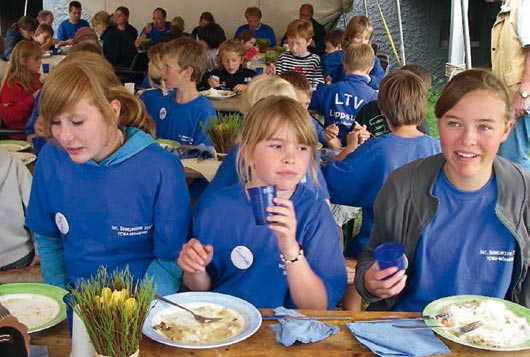 Tuesday morning was under the banner of sailing together. The Scots and the eight participating kids from RFCM happily shared the youth boats, with mixed teams on each boat. In the afternoon, they visited the Möhnesee dam wall together. This interesting trip lead them deep into the moist and chilly inside of the dam (the biggest part of the necessary explanations was given in English). After so much activity and fresh air, the day ended quietly with the joint dinner.
Tuesday morning was under the banner of sailing together. The Scots and the eight participating kids from RFCM happily shared the youth boats, with mixed teams on each boat. In the afternoon, they visited the Möhnesee dam wall together. This interesting trip lead them deep into the moist and chilly inside of the dam (the biggest part of the necessary explanations was given in English). After so much activity and fresh air, the day ended quietly with the joint dinner.
On Wednesday morning, we went to the Lörmecke tower with the eight RFCM kids directly after breakfast. Unhappily for the “poor” kids or youngsters, this meant a march of about three kilometres to the lookout tower. But they were compensated by the broad view of the beautiful Sauerland – after all, the tower is 35m high. After this, they paid a compulsory visit to the partner district Hochsauerlandkreis, where they were friendly welcomed by the deputy Kreisdirektor Winifried Stork. Having finished their lunch in the canteen of the Meschede Kreishaus, they visited or rather walked across the Winterberg bob run in heavy rain. The kids could put their theoretical knowledge into practice on the summer toboggan run immediately. At 20 o’clock, everybody returned to the youth hostel.
 Thursday started with sailing together and practicing eagerly for the regatta. The boat crews were mixed “internationally” again. After the tasty lunch, the first regatta rounds were carried out already.
Thursday started with sailing together and practicing eagerly for the regatta. The boat crews were mixed “internationally” again. After the tasty lunch, the first regatta rounds were carried out already.
In the evening, the youth hostel’s skittle alley was intensively used by the participating youngsters. The teams were mixed again, with one Scot and one German acting as the two team leaders. After the almost unbeatably exciting “skittles thriller”, the very narrow team victory went to the group led by the Scottish “chief”. Therefore the Scottish sailors could take the cup home to the island. But next year, the cup will go back to the Möhne – the narrowly defeated team is sure of that. Not all of the youngsters wanted to leave the Scots after the skittles, David and Michael stayed in the youth hostel overnight.
 And on Friday morning, they made long faces! The Möhnesee was smooth as glass, with no wind at all, absolutely nothing! It was good that the first regatta rounds had taken place the day before. Some very stalwart ones could not be stopped from going to the lake with a few boats, but it was a sad languishing. Fortunately, around noon a little wind came up, so that the boats could still move a little bit.
And on Friday morning, they made long faces! The Möhnesee was smooth as glass, with no wind at all, absolutely nothing! It was good that the first regatta rounds had taken place the day before. Some very stalwart ones could not be stopped from going to the lake with a few boats, but it was a sad languishing. Fortunately, around noon a little wind came up, so that the boats could still move a little bit.
Before the presentation ceremony in the afternoon, some parents and companions had to prove that they, too, are capable of mastering diffcult tasks in the world of sailing. Two teams were formed to compete with each other. The task was to free a charming princess first, then to bring the children back to the landing stage and fnally, to prove themselves in a tugofwar. All that sounds very easy, but to free the princess from her boat, one had to walk over three joint surfboards first to reach her. And the tug-of-war was in a place inside the lake where nobody was touching the ground again! “This really reminded me the show “Spiel ohne Grenzen” (game without limits). At least, all of us got shower chips after that, so that we could warm up again”, youth offcer Reinhard Bartsch remembers.
At the formal presentation ceremony attended by the deputy heads of both participating sailing clubs, no one went away emptyhanded! Everybody received a medal and different sponsored gifts like torches or USB sticks. The evening finished off with a joint barbecue.
On the last day, the Scots and the youngsters from the RFCM participated together in the summer regatta of the SMS. Due to a fortunately high number of participants of the regatta, it was quickly agreed that the youngsters should be judged separately, which meant staggered starts. The first round started at 11:30 o’clock. Half an hour after the last boat had crossed the fnish, the second exciting regatta round followed. In victorious mood, everybody then enjoyed the fortifying grilled food, and the kids had the chance to let off steam on the nice SMS premises.
At the presentation ceremony, every participant received a medal again. After a slightly sentimental review of the very successful week, the hosts insisted on giving George and Chris some regional specialties for going, too. Most especially the “Chris water” is to be mentioned here – a new term for a popular German hop drink that camera man Chris had especially warmed up to.
And then, until late into the night, everybody celebrated the regatta, the successful youth exchange, the many new positive impressions and the friendships developing among the children, youngsters and companions from both countries in particular.
The result for the sailing community: a totally successful cheerful and exciting week, in which certainly many prejudices were broken down and friendships built up. The initial skepticism turned into enthusiasm! Since the first visit in 2009, reciprocal visits are taking place every year.
Charity Run from West Lothian to Hochsauerlandkreis
by Astrid Schürmann / Sue Cook
In May 2011, five cyclists from West Lothian cycled from Livingston in West Lothian to Meschede in Germany. The cyclists were all ordinary people from very different walks of life: former Chief Executive of West Lothian Council Alex Linkston, Frank Anderson, a local politician, David Brice, who owns the Cupcake Cafe bar – a wellknown cafe and school which teaches cake decorating – with the very wellknown local celebrity Paul Bradford. Then Adrian Brady, Director of a multi million pound recruitment company, Sue Cook, local Justice of Peace and Ann Margaret Watson who works in the offce of the local Minister of Scottish Parliament. And a very important part of our team was Gordon Connolly who drove the van and our luggage!
We wanted to take the trip of 700 km to the town which West Lothian is twinned with. Our journey started in Livingston and it took us one week to arrive in Meschede. We cycled from Livingston to Newcastle where we took the ferry to Ijmuiden in Amsterdam. After Amsterdam we went to Arnhem, Xanten, Duisburg, Dortmund, Hamm and fnally Meschede. From Duisburg we followed the path of the RuhrtalRadweg along the Ruhr and we loved this route. One of the days when going from Xanten to Duisburg, we got lost and a wonderful German cyclist called Alfe cycled with us and took us a much longer, but very scenic route to Duisburg! The German cyclists were all so friendly and made our trip very memorable.
In Fröndenberg, we were welcomed by Wolfgang Meier, a member of the HSK District Administration who joined us for the last part of the way. And Erhard Schäfer, the head of the West LothianHochsauerlandkreis partnership union insisted on joining the group for some part of the way, too.After arriving at the Kreishaus and full of excitement about the Ruhrtalradweg, we decided to continue the Charity Run the following day in order to master its last stage to Winterberg. And on the way to Winterberg, Wolfgang Meier accompanied us one more time.
 On Saturday evening, back from Winterberg, we were cordially welcomed by the Vice District Administrator Dr Michael Schult with a small reception. And on Sunday afternoon, after a short Möhnesee trip, we left for Scotland again.
On Saturday evening, back from Winterberg, we were cordially welcomed by the Vice District Administrator Dr Michael Schult with a small reception. And on Sunday afternoon, after a short Möhnesee trip, we left for Scotland again.
On Saturday evening, back from Winterberg, we were cordially welcomed by the Vice District Administrator Dr Michael Schult with a small reception. And on Sunday afternoon, after a short Möhnesee trip, we left for Scotland again.
 We were raising money for 4 charities. The first two are national charities and are part of Prince Charles charities that he supports: Princes Scottish Youth Business Trust which gives money to young people aged 1825 to help them start their own business and Princes Trust which helps young disadvantaged people. The two local charities were River Kids, a charity for children in West Lothian and Open Doors which helps homeless people. Most schools in West Lothian were also involved in the fundraising and they were able to follow us live by using our website and seeing exactly where we were using Google Earth.
We were raising money for 4 charities. The first two are national charities and are part of Prince Charles charities that he supports: Princes Scottish Youth Business Trust which gives money to young people aged 1825 to help them start their own business and Princes Trust which helps young disadvantaged people. The two local charities were River Kids, a charity for children in West Lothian and Open Doors which helps homeless people. Most schools in West Lothian were also involved in the fundraising and they were able to follow us live by using our website and seeing exactly where we were using Google Earth.
Every picture tells a story – part 1
by Liz Liddell
Since the beginning of our partnership thousands of pictures have been taken of the many visits of groups to and from the Hochsauerland and West Lothian… too many to include in this book. Here is a selection of the many photographs taken over the past 40 years. From the signing of the agreement in 1972 some of the milestones of early barbeques, trips to attractions, presentations of gifts, meetings of friends. Fond memories of smiling friends and colleagues, sadly some of them no longer with us. Let the pictures tell the story.
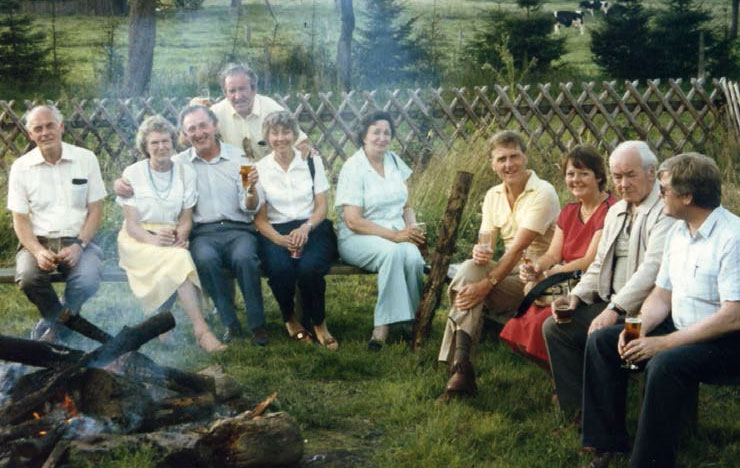
West Lothian Twinning Association visit Hochsauerland, July 1985 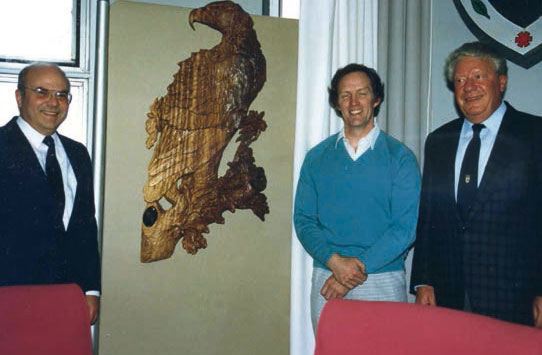
Presentation of eagle from West Lothian District Council to Hochsauerlandkreis, May 1987 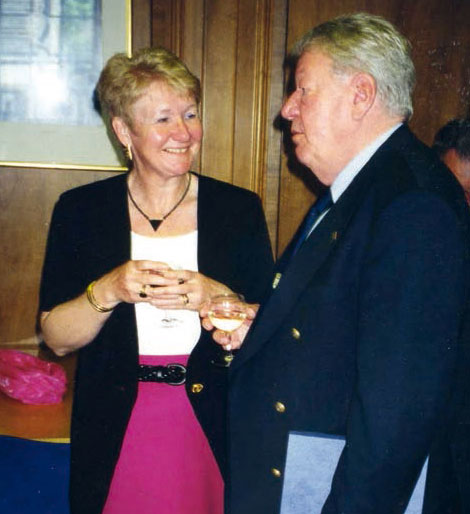
Liz Liddell and Landrat Rolf Fullgrabe, June 1997 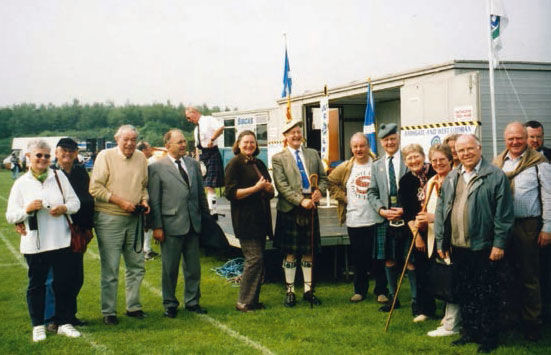
Twinning Group from Hochsauerland enjoy a day the Bathgate Highland Games, May 2003 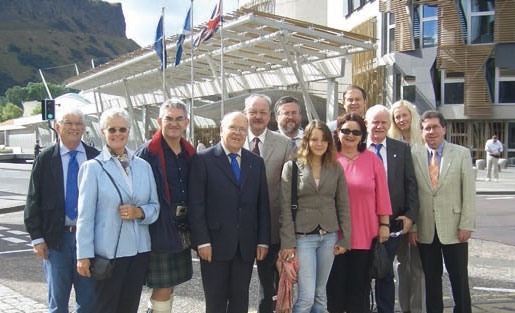
Hochsauerland Twinning members pose outsideScottish Parliament, August 2005 
WL to Bert, Jim, Rudi and Barbara, 2008 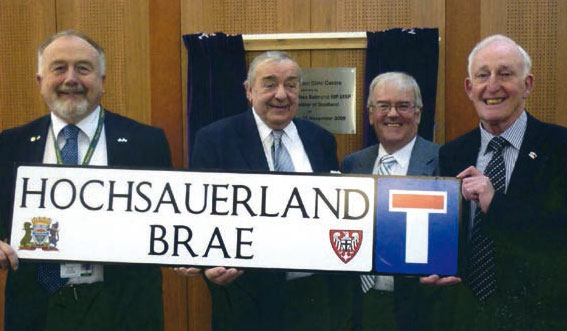
Name of road into New Civic Centre, 29 Novenber 2009 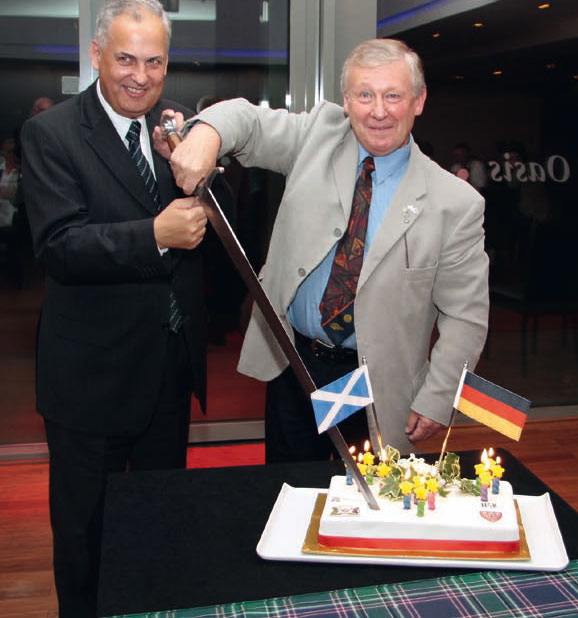
Landrat Dr Karl Schneider and Provist Tom Kerr cut the cake to celebrate 35 years of partnership. 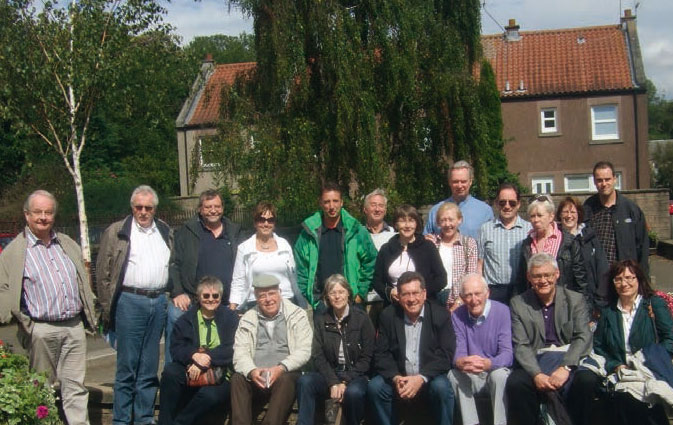
HSK Group at Low Port Centre Linlithgow, 2011
Friendship without borders
by Astrid Schürmann
“Here we go again” – that was the motto of the partnership between the Linlithgow Academy and Arnsberg’s School of Music Choir for many years. Young Arnsberg Choir members visited guest families in Scottish West Lothian a total of fve times in the 80’s and 90’s. With the families of the Linlithgow Academy students, they became familiar with the daily lives of their guest families and came to appreciate their friendliness and special form of hospitality..
It’s hard to imagine the conditions under which the visits back and forth between the choirs, the travel plans, and the concerts in St. Michael’s Church, Linlithgow and Edinburgh were planned: no emails, no mobile phones, no laptops… only telephone booths, letters and a camera with a fash cube on top. The amazing organizational skills of Maureen Rhode in Linlithgow and Rosemarie Schüttler in Arnsberg are in no small part to thank for the fact that still, to this day, after so many years, the visits are looked back so vividly and fondly upon.
The numerous Arnsberg Choir concerts, under the direction of its founder, Gerd Schüttler, are still fondly remembered in Scotland and were the highpoint of the concert travels. Under his leadership, the singers were able to thrill full houses in the worldrenowned St. Giles Cathedral on the Royal Mile in the capital city of Edinburgh.
The choir served as musical and vocal embassadors for the Sauerland region of Germany using pieces from Mozart, Schubert and the Arnsberg composer, Gustav Biener. The choir was expected to practice and present amazing pieces of music with enthusiasm and cheerfulness.
West Lothian and the Sauerland are separated by over hundreds of kilometres – a foreign language, a foreign land. All of the concert trips (’82, ’83, ’87, ’91 and 1995) are everpresent in the minds of the participants, due to the great performances, the Scottish landscape, and of course due to the friendliness, generousness and noticeably relaxed attitude of the guest families. At the GermanScottish farewell evening during the first trip, Musicdirector Gerd Schüttler shared his hope, “That this idea of friendship would take root and bear fruit again and again…”. The proof that this idea of a friendship between two peoples is still alive and bears fruit are the contacts which remain and the regular visits, still today, over the Channel… and beyond!
Every picture tells a story – part 2
by Wilfried Gundel / Astrid Schürmann
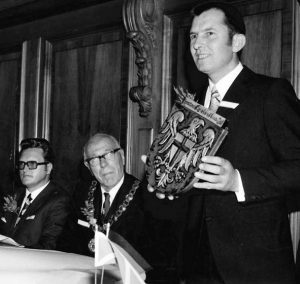
On the occasion of signing the partnership certificate in August 1972, Landrat Ferdi Tillmann (at his right District Administrator Peter Walker, next to him Kreisdirektor Dr Cronau) presents the coat of arms of the Arnsberg district. 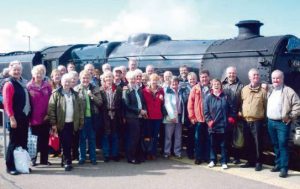
A part of the visiting programme of the HSK group in September 2009 was a train ride with the historic steam locomotive “The Jacobite” up to Mallaig at the west coast of Scotland. 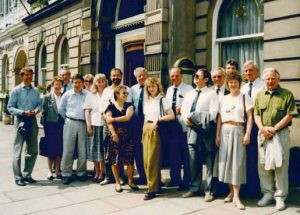
A group of travellers from HSK in George Street in Edinburgh 25 years ago. 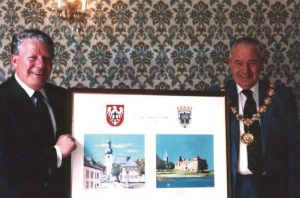
Dominic McCauley and Landrat Rolf Füllgräbe during a picture presentation on the occasion of the 10th anniversary of the partnership. 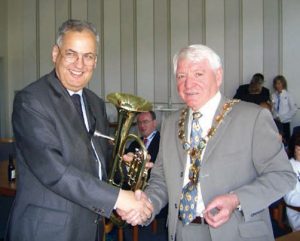
There is a lot of music in the partnership. The appropriate gift was presented to Provost Joe Thomas by Landrat Dr Karl Schneider during a HSK visit. 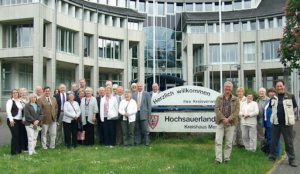
Visit of the West Lothian Twinning Association in HSK, 2008 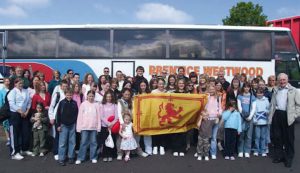
Youth Exchange 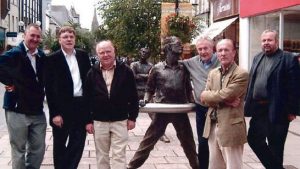
Meetings in Scotland, 2004. 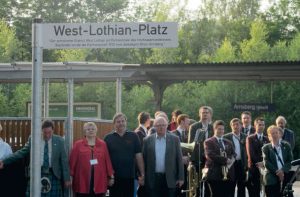
Unveiling of the West Lothian Platz at the new „Bürgerzentrum Arnsberg“, 26th June 2012. 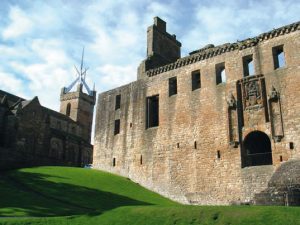
Linlithgow Palace: Birthplace of Mary, Queen of Scots (1542). 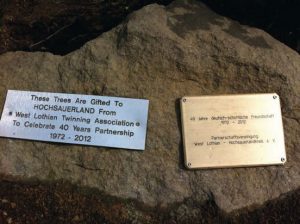
Planting trees in the Brilon Bürgerwald (June 2012): One seedling for each year of the partnership. 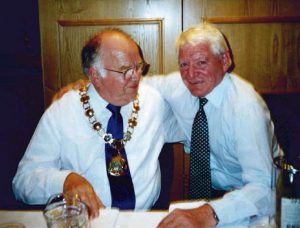
As a sign of unity, Provost Joe Thomas let the Head of the Partnership Association Erhard Schäfer have his Provost’s chain briefly. 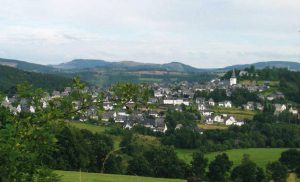
Landscape of Sauerland 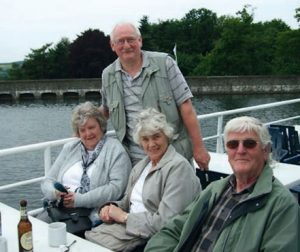
Isabel Clark, Tom and Ann Walker, Rudolf Brüschke on the Lake Möhne. 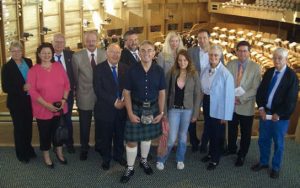
Occasionally, a trip to the Scottish Parliament (here the large debating chamber) in Edinburgh is part of the West Lothian visiting programme, 2005 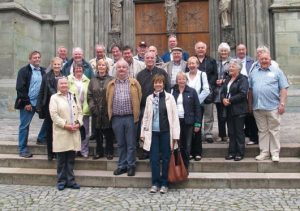
Visit of the West Lothian Twinning Association, 2012. 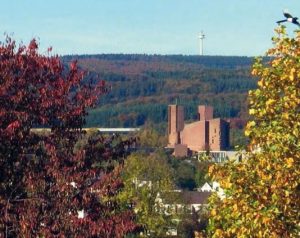
View of the Benedictine Königsmünster Abbey church. 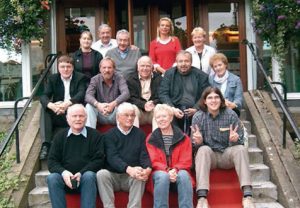
This HSK group enjoyed the visiting programme in West Lothian in 2004. 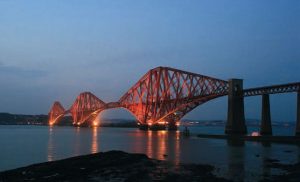
The „Firth of Forth“ (gael.: Abhainn Dhubh) is a firth on Scotland’s east coast and also the North Sea estuary of the Forth river. In the North lies the County of Fife, in the South the Counties of Midlothian and West Lothian as well as the city of Edinburgh. The Forth Bridge is a railway bridge over the Firth of Forth. It connects Edinburgh with the Fife peninsula and is the most important connection between the Scottish Lowlands and the Highlands. South Queens-ferry at the southern end of the bridge belonged to West Lothian (Linlithgowshire) before the territorial re-structuring.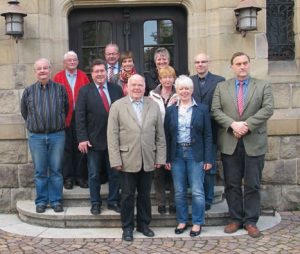
Board 2012 (from left): Wilfried Gundel, Bernhard Lenze, Ulrich Blum, Jürgen Kloß, Astrid Schürmann, Erhard Schäfer, Andrea Jolmes, Elke Fleischmann, Barbara Köster-Ewald, Sebastian Schüttler, Dr. Bernhard Wedeking. Missing: Paul-Ernst Altenwerth und Dr. Karl Schneider.

